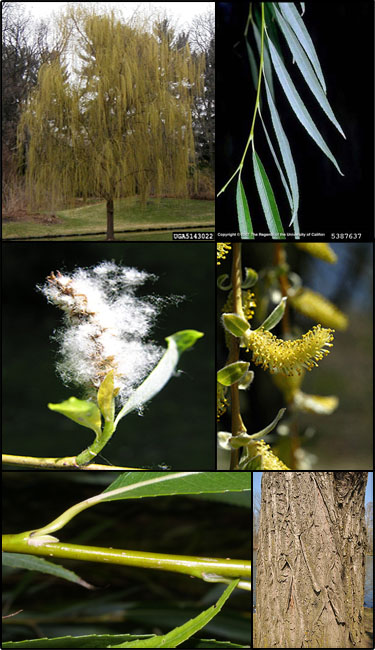Weeping willow (Salix babylonica)
 Description: Introduced to North America as an ornamental.
Description: Introduced to North America as an ornamental.Habit: Perennial tree to 40 ft tall; rounded crown; long, hanging branches; grayish-brown, irregularly furrowed bark.
Leaves: Alternate, simple, very narrowly lance-shaped, finely serrated margin, yellow-green above and milky green below, 3-6 inches in length, 3/8 to 1/2 inch in width.
Stems: Very slender; smooth; olive-green to pale yellowish brown; hanging or drooping for long distances; almost rope-like; buds are small, appressed and covered by a single, cap-like scale; terminal buds lacking.
Flowers: Dioecious, males and females appear as upright catkins and are quite fuzzy, 1 inch long, appearing before or with the leaves.
Fruit and seeds: A 1 in long cluster of valve-like capsules, light brown in color, contains many fine, cottony seeds; ripen in late May to early June.
Habitat: Native to Asia.
Reproduction: By herbaceous stem cuttings, woody stem cuttings or softwood cuttings.
Similar species: White Willow (Salix alba); Black Willow (Salix nigra); Corkscrew Willow (Salix matsudana Koidzumi ).
Monitoring and rapid response: Hand pull small seedlings; use machinery to remove larger trees and root systems in dry areas; effectively controlled using any of several readily available general use herbicides such as glyphosate. Credits: The information provided in this factsheet was gathered from the USDA PLANTS Database and Virginia Tech Department of Forest Resources and Environmental Conservation VTree.
Individual species images that appear with a number in a black box are courtesy of the Bugwood.org network (http://www.invasive.org).Individual photo author credits may not be included due to the small display size of the images and subsequent difficulty of reading the provided text. All other images appear courtesy of Google (http://images.google.com).
Common Name: | Weeping willow |
Scientific Name: | Salix babylonica |
Family: | Salicaceae (Willow) |
Duration: | Perennial |
Habit: | Trees |
USDA Symbol: | SAPE12 |
